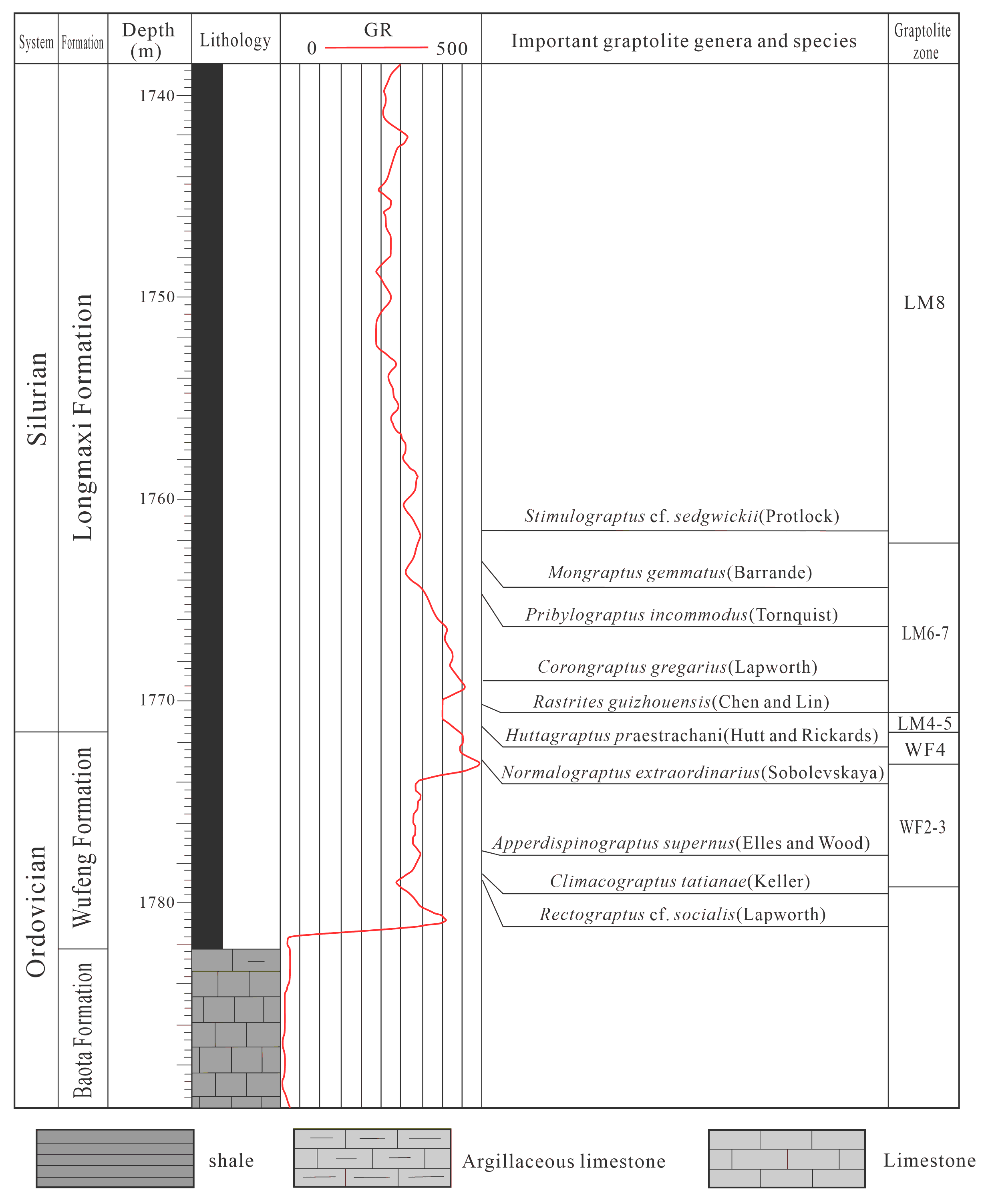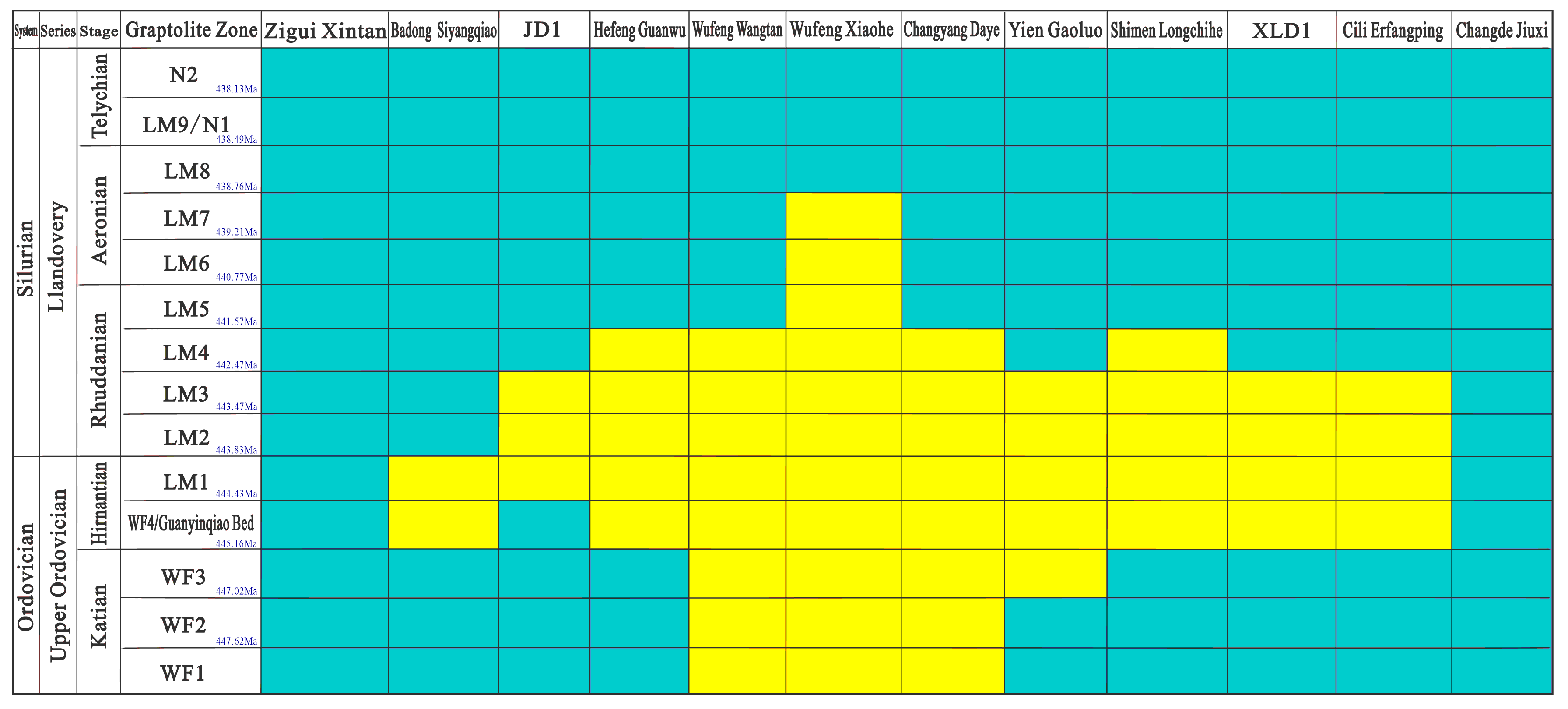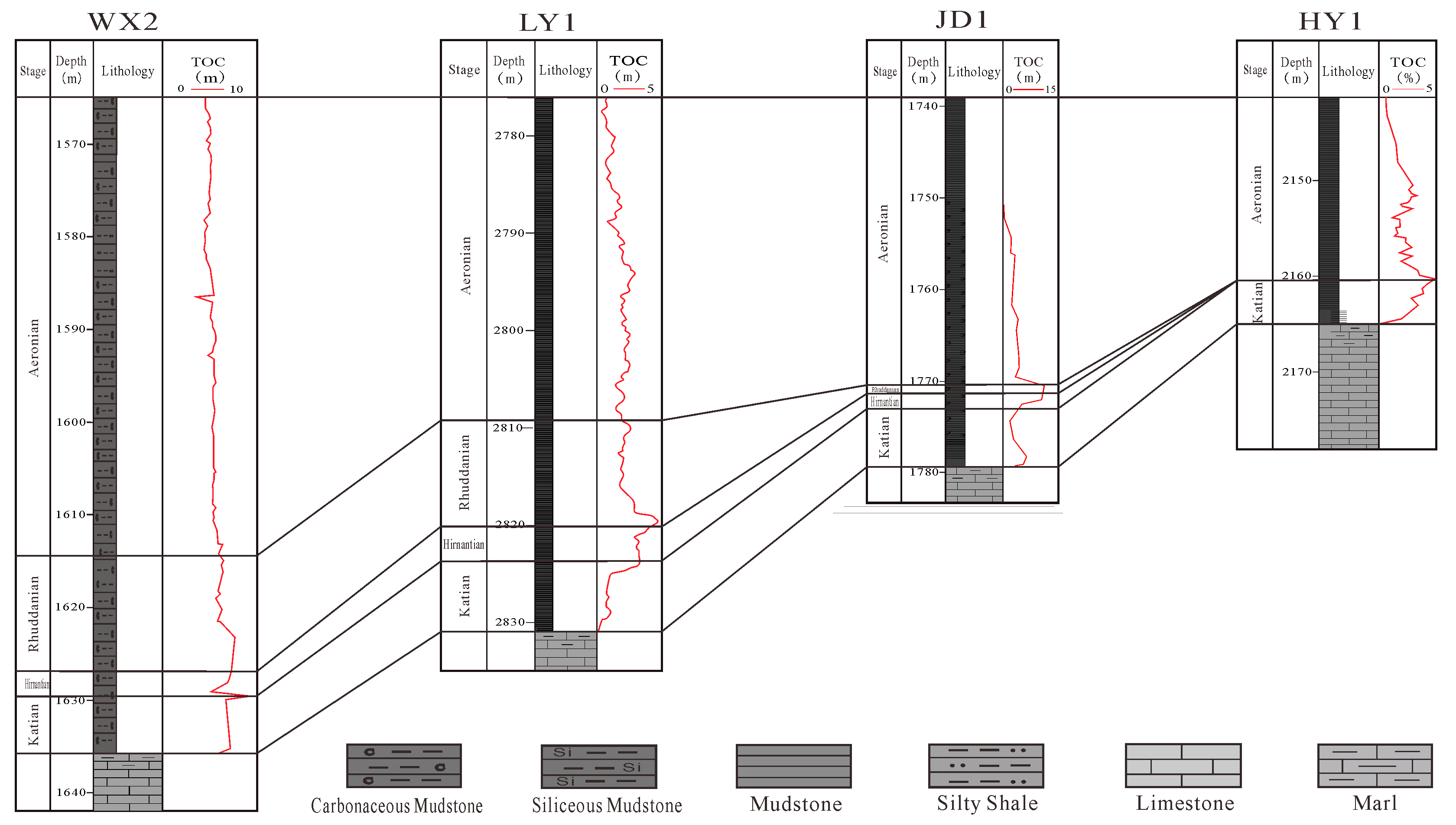The Range and Evolution Model of the Xiang-E Submarine Uplifts at the Ordovician–Silurian Transition: Evidence from Black Shale Graptolites
Abstract
:1. Introduction
2. Geological Background
3. Research Data and Methods
3.1. Research Data
3.2. Research Methods
4. Results and Discussion
4.1. Graptolite Shale Stratigraphy Correlation
4.2. The Range of the Xiang-E Submarine Uplifts
4.3. Evolution Model of the Submarine Uplifts
4.4. The Evolution Mechanism of Submarine Uplifts

4.5. Influence on Shale Gas Accumulation
5. Conclusions
- (1)
- The results of graptolite stratigraphic correlation of wells and outcrop sections in the Western Hunan–Hubei region confirmed the development of the Xiang-E submarine uplifts during the Ordovician–Silurian transition. It shows an evolutionary pattern of continuous uplift from the Katian Age to the early Rhuddanian Age, with a gradually expanding influence range, followed by a gradual shrinkage during the middle to late Rhuddanian Age. The initial form of the Xiang-E submarine uplift may have originated from the Guangxi movement, and the global sea-level rise and fall cycles caused by the condensation and melting of polar glaciers are the primary controlling factors for the changes in the influence range of the Xiang-E submarine uplifts.
- (2)
- Within the range of the Xiang-E submarine uplifts, at least two graptolite zone organic-rich shales of WF2-LM4 in the Wufeng Formation and Longmaxi Formation are generally absent, resulting in poor material basis for shale gas accumulation and hydrocarbon generation and a higher exploration risk. However, the Silurian strata in areas such as Xianfeng, Lichuan, Yichang in Hubei, and Wushan in Chongqing have good potential for shale gas exploration and development. The research findings can provide important references for shale gas area evaluation and the next steps of exploration deployment in southern China.
- (3)
- This study, based on data from 23 outcrop points and 11 wells in the Western Hunan–Hubei region, investigates the range and evolution model of the Xiang-E submarine uplifts. The data coverage is limited and primarily relies on the black shale graptolite stratigraphy correlation. Future work should focus on strengthening the sampling of drillings and outcrop points, as well as expanding the geographical coverage. This will further elucidate the spatial distribution and subsurface structural characteristics of the Xiang-E submarine uplifts and enhance the precision of its characterization. Integrate high-precision 3D seismic data with geochemical tracing to deepen the study of uplift-controlled hydrocarbon accumulation mechanisms.
Author Contributions
Funding
Data Availability Statement
Conflicts of Interest
References
- Guo, T.L.; Zhang, H.Y. Formation and enrichment mode of Jiaoshiba shale gas field, Sichuan Basin. Pet. Explor. Dev. 2014, 41, 28–36. [Google Scholar] [CrossRef]
- Zou, C.N.; Dong, D.Z.; Wang, Y.M.; Li, X.J.; Huang, J.L.; Wang, S.F.; Guan, Q.Z.; Zhang, C.C.; Wang, H.Y.; Liu, H.L.; et al. Shale gas in China: Characteristics, Challenges and Prospects(I). Pet. Explor. Dev. 2015, 42, 689–701. [Google Scholar] [CrossRef]
- Zhao, W.Z.; Li, J.Z.; Yang, T.; Yang, T.; Wang, S.F.; Huang, J.L. Geological difference and its significance of marine Shale Gases in South China. Pet. Explor. Dev. 2016, 43, 499–510. [Google Scholar] [CrossRef]
- Dong, D.Z.; Shi, Z.S.; Guan, Q.Z.; Jiang, S.; Zhang, M.Q.; Zhang, C.C.; Wang, S.Y.; Sun, S.S.; Yu, R.Z.; Liu, D.X.; et al. Progress, challenges and prospects of shale gas exploration in the Wufeng–Longmaxi reservoirs in the Sichuan Basin. Nat. Gas Ind. 2018, 38, 67–76. [Google Scholar] [CrossRef]
- Jin, Z.J.; Hu, Z.Q.; Gao, B.; Zhao, J.H. Shale Gas enrichment and high yield control factors of the Wufeng Formation—Longmaxi Formation in Southeastern Sichuan. Earth Sci. Front. 2016, 23, 1–10. [Google Scholar]
- Guo, X.S.; Hu, D.F.; Li, Y.P.; Wei, Z.H.; Wei, X.F.; Liu, Z.J. Geological factors controlling shale gas enrichment and high production in Fuling shale gas field. Pet. Explor. Dev. 2017, 44, 481–491. [Google Scholar] [CrossRef]
- Ma, X.H.; Xie, J. The progress and prospects of shale gas exploration and exploitation in southern Sichuan Basin, NW China. Pet. Explor. Dev. 2018, 45, 161–169. [Google Scholar] [CrossRef]
- Wang, J.; Bao, H.Y.; Lu, Y.Q.; Liu, J.; Zhang, M.Y. Quantitative characteristics and main controlling factors of shale gas Occurrence in Jiaoshiba, Fuling. Earth Sci. 2018, 44, 1001–1011. [Google Scholar]
- Chen, X.; Fan, J.X.; Zhang, Y.D.; Wang, H.Y.; Chen, Q.; Wang, W.H.; Liang, F.; Guo, W.; Zhao, Q.; Nie, H.K.; et al. Division and Delineation of Black Shale in Yangtze coverage Area of Wufeng Formation and Longmaxi Formation. J. Stratigr. 2015, 39, 351–358. [Google Scholar]
- Zou, C.N.; Gong, J.M.; Wang, H.Y.; Shi, Z.S. Importance of Graptolite Evolution and Biostratigraphic Calibration on Shale Gas Exploration. China Pet. Explor. 2019, 24, 1–6. [Google Scholar] [CrossRef]
- Chen, X.; Rong, J.Y.; Zhou, Z.Y.; Zhang, Y.D.; Zhan, R.B.; Liu, J.B.; Fan, J.X. The Central Guizhou and Yichang Uplifts, Upper Yangtze region, between Ordovcian and Silurian. Chin. Sci. Bull. 2001, 46, 1052–1056. [Google Scholar]
- Rong, J.Y.; Chen, X.; Wang, Y.; Zhan, R.B.; Liu, J.B.; Huang, B.; Tang, P.; Wu, R.C.; Wang, G.X. Transition of the central guizhou continent at the turn of the ordovician and Silurian: Evidence and revelation. Sci. China Earth Sci. 2011, 41, 1407–1415. [Google Scholar]
- Nie, H.K.; Jin, Z.J.; Bian, R.K.; Du, W. The accumulation of Shale Gas “Source cap controlled Reservoir” in the Wufeng Formation of the Upper Ordovician and the Longmaxi Formation of the lower Silurian. J. Oil 2016, 37, 557–571. [Google Scholar] [CrossRef]
- Sun, Y.C. Bases of the chronological classification with special reference to the Palaeozoic stratigraphy of China. Bull. Geol. Soc. China 1943, 23, 35–56. [Google Scholar] [CrossRef]
- Chen, X.; Rong, J.Y.; Li, Y.; Yue, L.; Boucot, A.J. Facies patterns and geography of the Yangtze region, South China, through the Ordovician and Silurian transition. Palaeogeogr. Palaeoclim. Palaeoecol. 2004, 204, 353–372. [Google Scholar]
- Fan, J.X.; Michael, J.M.; Chen, X.; Wang, Y.; Zhang, Y.D.; Chen, Q.; Chi, Z.L.; Chen, F. Biostratigrapand geography of the Ordovicim-Silurim Luugmacbi black sbales in South China. Sci. China Earth Sci. 2012, 42, 130–139. [Google Scholar]
- Zhou, Z.; Zhai, G.Y.; Shi, D.S.; Wang, S.J.; Guo, T.X.; Liu, Y.M.; Wang, H. Shale Gas Reservoir Geology of the Upper Ordovician Wufeng Formation-Lower Silurian Longmaxi Formation in western Hubei and northeastern Chongqing. Pet. Geol. Exp. 2019, 41, 1–9. [Google Scholar]
- Feng, Z.Z.; Peng, Y.M.; Jin, Z.K.; Jiang, P.L.; Bao, Z.D.; Luo, Z.; Ju, T.Y.; Tian, H.Q.; Wang, H. Lithofacies Paleogeography of the Middle and Late Ordovician in South China. J. Paleogeography 2001, 10–24+96–99. [Google Scholar]
- Lu, Y.B.; Ma, Y.Q.; Wang, Y.X.; Wang, Y.X.; Lu, Y.C. The sedimentary response to the major geological events and lithofacies characteristics of Wufeng Formation-Longmaxi Formation in the Upper Yangtez area. Earth Sci. 2017, 42, 1169–1184. [Google Scholar]
- Zhou, X.F.; Guo, W.; Li, X.Z.; Zhang, X.W.; Liang, P.P.; Yu, J.M. Mutual relation between organic matter types and pores with petro logical evidence of radiolarian siliceous shale in Wufeng Longmaxi Formation, Sichuan Basin. J. China Univ. Pet. (Ed. Nat. Sci.) 2022, 46, 12–22. [Google Scholar]
- Su, W.B.; Huff, W.D.; Ettensohn, F.R.; Liu, X.M.; Zhang, J.E.; Li, Z.M. K-bentonite, black-shale and flysch successions at the Ordovician-Silurian transition, South China: Possible sedimentary responses to the accretion of Cathaysia to the Yangtze block and its implications for The evolution of Gondwana. Gondwana Res. 2009, 15, 111–130. [Google Scholar] [CrossRef]
- Wang, C.; Zhang, B.Q.; Shu, Z.G.; Lu, Y.Q.; Bao, H.Y.; Yang, W.X.; Liu, C.; Li, K. Shale Lamination and Its influence on Shale Reservoir Quality of Wufeng Formation—Longmaxi Formation in Jiaoshiba Area. Earth Sci. 2019, 44, 972–982. [Google Scholar]
- Qiu, Z.; Zou, C.N. Unconventional petroleum sedimentology: Connotation and prospect. Acta Sedimentol. Sin. 2020, 38, 129. [Google Scholar]
- Gradstein, F.M.; Ogg, J.G.; Schmitz, M.D.; Ogg, G.M. On the Geologic Time Scale; Elsevier: Amsterdam, The Netherland, 2012. [Google Scholar] [CrossRef]
- Zhou, X.J.; Yang, F. Tectonic-Palaeogeographic Evolution of the South China Continent during the Late Caledonian. Pet. Geol. Exp. 2009, 31, 128–135+141. [Google Scholar]
- Wang, C.S.; Wang, X.F.; Wei, K.; Zeng, X.W.; Wang, J.P.; Li, Y.G. The Silurian Sea Level Changes and Sequence Stratigraphic Division and Correlation in Western Hunan and Hubei Provinces. South China Geol. 2022, 38, 67–78. [Google Scholar]
- Chen, X.; Chen, Q.; Zhen, Y.Y.; Wang, H.Y.; Zhang, L.N.; Zhang, J.P.; Wang, W.H.; Xiao, Z.H. Circumjacent distribution pattern of the Lungmachian graptolitic black shale (early Silurian) on the Yichang Uplift and its peripheral region. Sci. China Earth Sci. 2018, 61, 1195–1203. [Google Scholar] [CrossRef]
- Rong, J.Y.; Wang, Y.; Zhan, R.B.; Fan, J.X.; Huang, B.; Tang, P.; Li, Y.; Zhang, X.L.; Wu, R.C.; Wang, G.X.; et al. Silurian integrative stratigraphy and timescale of China. Sci. China Earth Sci. 2019, 62, 89–111. [Google Scholar] [CrossRef]
- Zhang, G.W.; Guo, A.L.; Wang, Y.J.; Li, S.Z.; Dong, Y.P.; Liu, S.F.; He, D.F.; Cheng, S.Y.; Lu, R.K.; Yao, A.P. Tectonics of South China Continent and Its Implications. Sci. China Earth Sci. 2013, 56, 1804–1828. [Google Scholar] [CrossRef]
- Wang, X.; Gao, X.F.; Zha, X.F. Tectonic Response of the Kwangsian Orogeny in the Northern Margin of the South China Block: Evidences from Biostratigraphy. Earth Sci. 2024, 49, 3199–3211. [Google Scholar]
- Xu, Y.J.; Du, Y.S. From Periphery Collision to Intraplate Orogeny: Early Paleozoic Orogenesis in South- eastern Part of South China. Earth Sci. 2018, 43, 333353, (In Chinese with English Abstract). [Google Scholar]
- Wang, Y.; Rong, J.Y.; Zhan, R.B.; Huang, B.; Wu, R.C.; Wang, G.X. On the Ordovician-Silurian boundary Strata in Southwestern Hubei, and the Yichang Uplift. J. Stratigr. 2013, 37, 264–274. [Google Scholar]
- Wang, Y.; Rong, J.Y.; Tang, P.; Huang, B.; Zhang, X.L.; Xu, H.H.; Liu, F.; Jiang, Q.; Wang, Y. Characteristics of Major Hiatus in Middle Paleozoic Rocks of South China and Their Significance of Geotectonics. Sci. China (Ser. D) 2021, 51, 218–240. (In Chinese) [Google Scholar]
- Isozaki, Y.; Aoki, K.; Nakama, T.; Yanai, S. New Insight into a Subduction-Related Orogen: A Reappraisal of the Geotectonic Framework and Evolution of the Japanese Islands. Gondwana Res. 2010, 18, 82–105. [Google Scholar] [CrossRef]
- Rong, J.Y.; Zhan, R.B.; Xu, H.G.; Huang, B.; Yu, G.H. Expansion of the Cathaysian Oldland through the Ordovician-Silurian transition: Emerging evidence and possible dynamics. Sci. China Earth Sci. 2010, 53, 1–17. [Google Scholar] [CrossRef]
- Shu, L.S.; Yao, J.L.; Wang, B.; Faure, M.; Charvet, J.; Chen, Y. Neoproterozoic plate tectonic process and Phanerozoic geodynamic evolution of the South China block. Earth-Sci. Rev. 2021, 216, 103596. [Google Scholar]
- Li, L.M.; Lin, S.F.; Xing, G.F. Identification of ca. 520 Ma mid-ocean-ridge-type ophiolite suite in the inner Cathaysia block, South China: Evidence from shearing-type oceanic plagiogranite. Geol. Soc. Am. Bull. 2022, 134, 1701–1720. [Google Scholar] [CrossRef]
- Hou, M.C.; Qi, L.; Li, K.Z.; Li, L.; Ren, Q.; Zhao, Z.L.; Hu, S.P.; Hu, J.J.; Wang, Z.W. Characteristics and key scientific issues of the “atypical” Caledonian orogeny in South China. Acta Geol. Sin. 2024, 98, 3503–3529. [Google Scholar]
- Zhang, J.H.; Liu, W.L.; Yakymchuk, C.; Sa, R.N.; Zeng, Z.; Ding, R.X.; Tang, G.J.; Liu, H.Q.; Xu, Q.Y.; Wang, Y. Partial Melting and Crustal Deformation during the Early Paleozoic Wuyi-Yunkai Orogeny: Insights from Zircon U-Pb Geochronology and Structural Analysis of the Fuhuling Migmatites in the Yunkai Region, South China. Minerals 2019, 9, 621. [Google Scholar] [CrossRef]
- Yan, D.T.; Chen, D.Z.; Wang, Q.C.; Wang, J.G. Large-scale climatic fluctuations in the latest Ordovician on the Yangtze block, south China. Geology 2010, 38, 599–602. [Google Scholar] [CrossRef]
- Boucot, A.J.; Rong, J.Y.; Chen, X.; Scotese, C.R. Pre-Hirnantian Ashgill climatically warm event in the Mediterranean region. Lethaia 2003, 36, 119–131. [Google Scholar] [CrossRef]
- Fortey, R.A.; Covks, L.R. Late Ordovician global warming the Boda event. Geology 2005, 33, 405–408. [Google Scholar]
- Rong, J.Y.; Zhan, R.M. Ordovician-Silurian Brachiopod turnover in South China. Geoscience 1999, 13, 390–394. [Google Scholar]
- Ghienne, J.F. Late Ordovician sedimentary environments, glacial cycles, and post-glacial transgression in the Taoudeni Basin, West Africa. Palaeogeogr. Palaeoclim. Palaeoecol. 2003, 189, 117–145. [Google Scholar] [CrossRef]
- Brenchley, P.J.; Marshall, J.D.; Harper, D.A.T.; Buttler, C.J.; Underwood, C.J. A late Ordovician (Hirnantian) karstic surface in a submarine channel, recording glacio-eustatic sea-level changes: Meifod, central Wales. Geol. J. 2006, 41, 1–22. [Google Scholar]
- Finnegan, S.; Bergmann, K.; Eiler, J.M.; Jones, D.S.; Fike, D.A.; Eisenman, I.; Hughes, N.C.; Tripati, A.K.; Fischer, W.W. The magnitude and duration of Late Ordovician-Early Silurian glaciation. Science 2011, 331, 903–906. [Google Scholar] [CrossRef]
- Spotila, J.A.; Prince, P.S. Geomorphic complexity and the case for topographic rejuvenation of the Appalachian Mountains. Geomorphology 2022, 417, 108449. [Google Scholar] [CrossRef]
- Trotter, J.A.; Williams, I.S.; Barnes, C.R.; Lécuyer, C.; Nicoll, R.S. Did cooling oceans trigger Ordovician biodiversification? Evidence from conodont thermometry. Science 2008, 321, 550–554. [Google Scholar]
- Song, H.J.; Wignall, P.B.; Song, H.Y.; Dai, X.; Chu, D.L. Seawater temperature and dissolved oxygen over the past 500 million years. J. Earth Sci. 2019, 30, 236–243. [Google Scholar]
- Goldberg, S.L.; Present, T.M.; Finnegan, S.; Bergmann, K.D. A high-resolution record of early Paleozoic climate. Proc. Natl. Acad. Sci. USA 2021, 118, e2013083118. [Google Scholar]
- Sun, J.P.; Dong, Y.P.; Chen, Q.; Yang, L.; Li, W.H.; Zhang, D.D.; Zhang, Q. Ordovician Tectonic Transition from Passive Margin into Peripheral Foreland in the Southern Ordos: A Diagnostic Insight into the Closure of Erlangping Ocean between the North Qinling Arc and North China Block. Basin Res. 2023, 35, 336–362. [Google Scholar] [CrossRef]
- Meyer, K.M.; Kump, L.R. Oceanic euxinia in Earth history: Causes and consequences. Annu. Rev. Earth Planet. Sci. 2008, 36, 251–288. [Google Scholar] [CrossRef]
- Yang, X.R.; Yan, D.T.; Zhang, L.W.; Xu, H.W.; Liu, W.H.; Yun, J.L. The Genesis of Hirnantian Glaciation and Paleo-Ocean Environment During Ordovician-Silurian Transition. Acta Sedimentol. Sin. 2018, 36, 319–332. [Google Scholar]
- Nie, H.K.; Jin, Z.J.; Zhang, J.C. Characteristics of three organic matter pore types in the Wufeng-Longmaxi shale of the Sichuan Basin, Southwest China. Sci. Rep. 2018, 8, 7014. [Google Scholar] [CrossRef]
- Wang, Y.M.; Li, X.J.; Wang, H.; Jiang, S.; Chen, B.; Ma, J.; Dai, B. Developmental Characteristics and geological significance of the bentonite in the Upper Ordovician Wufeng-Lower Silurian Longmaxi Formation in eastern Sichuan Basin, SW China. Pet. Explor. Dev. 2019, 46, 653–665. [Google Scholar] [CrossRef]
- Yan, D.T.; Chen, D.Z.; Wang, Z.Z.; Li, J.; Yang, X.R.; Zhang, B. Climatic and oceanic controlled deposition of Late Ordovician-Early Silurian black shales on the North Yangtze platform, South China. Mar. Pet. Geol. 2019, 110, 112–121. [Google Scholar]
- Nie, H.K.; Wang, H.; He, Z.L.; Wang, Y.Y.; Zhang, P.X.; Peng, Y.M. Formation mechanism, distribution and exploration prospect of normal pressure Shale Gas reservoir:a case study of Wufeng Formation-Longmaxi Formation in Sichuan Basin and its periphery. J. Oil 2019, 40, 131–164. [Google Scholar] [CrossRef]





| Num | Well Name | Structural Type | Stratigraphic Development Characteristics | Base Depth (m) | Thickness of Shale with TOC > 2.0% (m) | Shale Gas Shows/Indications |
|---|---|---|---|---|---|---|
| 1 | EYY2 | Monoclinal structure | WF2-LM4 zone is fully developed | 2722.0 | 21.0 | Daily gas production from horizontal well: 3.15 × 104 m3 |
| 2 | XD2 | Residual syncline | WF2-LM4 zone is fully developed | 1520.0 | 28.0 | Field desorption gas content: maximum 3.5 m3/t; average 2.56 m3/t (28 samples) |
| 3 | EZY1 | Monoclinal structure | WF2-LM4 zone is fully developed | 2060.0 | 20.4 | Field desorption gas content: maximum 4.2 m3/t; average 3.0 m3/t (20 samples) |
| 4 | SY1 | Monoclinal structure | Absence of WF4-LM4 zones | 1595.0 | 12.0 | Field desorption gas content: average 0.1 m3/t |
| 5 | JD1 | Anticline | Absence of LM1-LM3 zones | 1782.3 | 24.5 | Field desorption gas content: maximum 0.92 m3/t |
| 6 | HY1 | Anticline | Absence of WF4-LM4 zones | 2165.0 | 12.6 | Log-interpreted gas content: maximum 1.4 m3/t |
| 7 | LD1 | Residual syncline | Absence of WF3-LM3 zones | 948.0 | 18.0 | Field desorption gas content: maximum 1.72 m3/t |
| 8 | XLD1 | Residual syncline | Absence of WF3-LM3 zones | 1504.0 | 11.0 | Field desorption gas content: average 0.43 m3/t |
| 9 | YY1 | Residual syncline | Absence of WF4-LM3 zones | 532.0 | 19.0 | Field desorption gas content: maximum 0.59 m3/t |
Disclaimer/Publisher’s Note: The statements, opinions and data contained in all publications are solely those of the individual author(s) and contributor(s) and not of MDPI and/or the editor(s). MDPI and/or the editor(s) disclaim responsibility for any injury to people or property resulting from any ideas, methods, instructions or products referred to in the content. |
© 2025 by the authors. Licensee MDPI, Basel, Switzerland. This article is an open access article distributed under the terms and conditions of the Creative Commons Attribution (CC BY) license (https://creativecommons.org/licenses/by/4.0/).
Share and Cite
Zhou, Z.; Zhou, H.; Jiang, Z.; Li, S.; Bao, S.; Xu, G. The Range and Evolution Model of the Xiang-E Submarine Uplifts at the Ordovician–Silurian Transition: Evidence from Black Shale Graptolites. J. Mar. Sci. Eng. 2025, 13, 739. https://doi.org/10.3390/jmse13040739
Zhou Z, Zhou H, Jiang Z, Li S, Bao S, Xu G. The Range and Evolution Model of the Xiang-E Submarine Uplifts at the Ordovician–Silurian Transition: Evidence from Black Shale Graptolites. Journal of Marine Science and Engineering. 2025; 13(4):739. https://doi.org/10.3390/jmse13040739
Chicago/Turabian StyleZhou, Zhi, Hui Zhou, Zhenxue Jiang, Shizhen Li, Shujing Bao, and Guihong Xu. 2025. "The Range and Evolution Model of the Xiang-E Submarine Uplifts at the Ordovician–Silurian Transition: Evidence from Black Shale Graptolites" Journal of Marine Science and Engineering 13, no. 4: 739. https://doi.org/10.3390/jmse13040739
APA StyleZhou, Z., Zhou, H., Jiang, Z., Li, S., Bao, S., & Xu, G. (2025). The Range and Evolution Model of the Xiang-E Submarine Uplifts at the Ordovician–Silurian Transition: Evidence from Black Shale Graptolites. Journal of Marine Science and Engineering, 13(4), 739. https://doi.org/10.3390/jmse13040739








